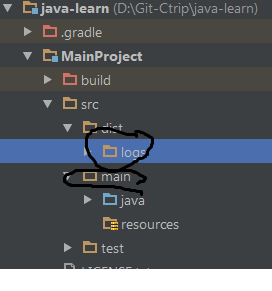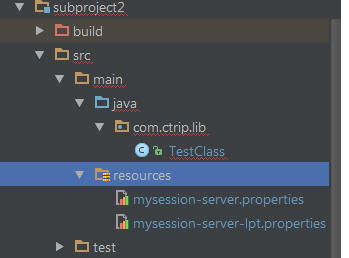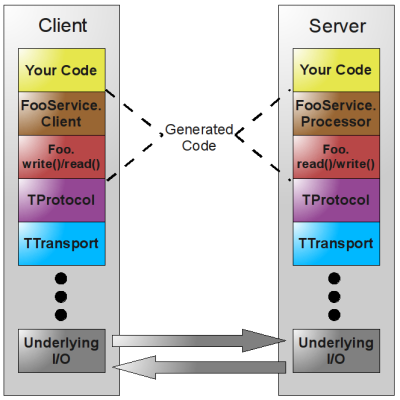一个Java项目的学习
1. java命令行的启动
首先是gradle build
其次是:java -Dabc.appid=1234 -classpath "a.jar:b.jar" com.ctrip.oss.MainClass 1>"d:\test\logs\log.txt" 2>"d:\test\errors\errors.txt"
其中:
-D后面的是运行时的配置参数,可以在代码中通过 System.getProperty('abc.appid')的方式获得
-classpath是编译完成后生成的*.jar文件路径
com.ctrip.oss.MainClass是程序运行开始的主类
1>如果代码中存在sl4j 这个参数后面的路径文件将用来存放log log文件,包括info, warn, error 信息
2>如果代码中存在任何未经捕获的异常,log信息会写到errors.txt文件中
如何配置sl4j的环境。 以下依赖是必须的
compile 'org.slf4j:slf4j-api:1.7.5'
代码中使用logger:
Logger logger = LoggerFactory.getLogger(this.getClass());
2. Logback 的使用,logback用来记录本地log
logback是用来配置Log写在什么地方的,这里将Log写在本地:
首先需要引用logback的dependency:
compile 'ch.qos.logback:logback-core:1.1.1' compile 'ch.qos.logback:logback-classic:1.1.1' compile 'ch.qos.logback:logback-access:1.1.1'
其次在resources目录下配置logback.xml.

<?xml version="1.0" encoding="UTF-8"?> <configuration> <property name="LOG_DIR" value="session-service/logs"/> <property name="LOG_FILE_NAME" value="session-server.log"/> <!-- Output to File and Rotate if it's necessary --> <appender name="ROLLING" class="ch.qos.logback.core.rolling.RollingFileAppender"> <file>${LOG_DIR}/${LOG_FILE_NAME}</file> <rollingPolicy class="ch.qos.logback.core.rolling.TimeBasedRollingPolicy"> <!-- rollover daily --> <fileNamePattern>${LOG_DIR}/${LOG_FILE_NAME}.%d{yyyy-MM-dd}.%i</fileNamePattern> <timeBasedFileNamingAndTriggeringPolicy class="ch.qos.logback.core.rolling.SizeAndTimeBasedFNATP"> <!-- or whenever the file size reaches 100MB --> <maxFileSize>100MB</maxFileSize> <maxHistory>10</maxHistory> </timeBasedFileNamingAndTriggeringPolicy> </rollingPolicy> <encoder> <pattern>%date [%-5thread] %-5level [%-10logger] %-10msg%n</pattern> </encoder> <filter class="com.ctriposs.session.util.LogLevelFilter"> <level>WARN</level> </filter> </appender> <root level="INFO"> <appender-ref ref="ROLLING"/> </root> </configuration>
最后在代码中加载这个xml 并且配置运行时环境变量

1 LoggerContext lc = (LoggerContext)LoggerFactory.getILoggerFactory(); 2 3 JoranConfigurator joranConfigurator=new JoranConfigurator(); 4 joranConfigurator.setContext(lc); 5 lc.reset(); 6 7 // Get the configuration xml file 8 String configurationFilePath=appName+"-logback.xml"; 9 InputStream stream = logConfigurator.class.getResourceAsStream(configurationFilePath); 10 11 // Configure the log context with the stream loaded 12 try { 13 joranConfigurator.doConfigure(stream); 14 } catch (JoranException e) { 15 e.printStackTrace(); 16 }
通过以上配置:在此配置之前的log会写在>1 和>2两个命令行参数所指定的log地址,但是当使用了log back之后的logger将使用最新的log地址
注意:
XML中配置的log地址是可以动态配置的,即通过在java命令的配置参数中使用 -DXX的形式
log所在的路径即/opt/test/session-service/logs, 这里/opt/test/session-service为classpath的根,logs文件夹应该提前在工程中与main相同的路径下新建好

2. Configuration的配置和使用。
上面提到了使用在启动命令中使用 -Dxxx 的方式传递配置参数,也可以使用一些开源的属性配置器来做
添加引用:
compile 'com.netflix.archaius:archaius-core:0.6.0'
使用代码:
// 首先设置全局变量,这两个变量
System.setProperty("archaius.deployment.applicationId", "mysession-server");
System.setProperty("archaius.deployment.environment", "lpt");
//获取以上设置
String appId = ConfigurationManager.getDeploymentContext().getApplicationId();
String environmentName = ConfigurationManager.getDeploymentContext().getDeploymentEnvironment();
//加载properties文件
ConfigurationManager.loadCascadedPropertiesFromResources(appId);
String settingName=ConfigurationManager.getConfigInstance().getString("setting1");
String settingName2=ConfigurationManager.getConfigInstance().getString("setting2");

*另外archious还提供了动态配置文件的作用,参照https://github.com/Netflix/archaius
3。由于要加在到classpath中的jar包随着工程的复杂而增加,所以手动的拼写所有的依赖包变得不现实,使用sh脚本语言将大大简化我们的工作
sourcelocation='/opt/test/MainProject-1.0/'
loglocation='/opt/test/MainProject-1.0/logs'
java -classpath $(echo /opt/test/MainProject-1.0/lib/* | tr ' ' ':') com.ctrip.test.mainClass 1>$loglocation/log.txt 2>$loglocation/error.txt
4. Handler 的添加。
在项目开发过程中往往要将内部的一些部分作为API对外公开,在.NET中是通过配置handler进行的。Java中可以通过一些服务器组件来实现,比如jetty,前半部分是Jetty的后半部分是序列化器的
compile 'org.eclipse.jetty:jetty-server:8.1.0.RC5'
compile 'org.eclipse.jetty:jetty-servlet:8.1.0.RC5'
compile 'org.eclipse.jetty:jetty-servlets:8.1.0.RC4'
compile 'com.fasterxml.jackson.core:jackson-core:2.3.3'
compile 'com.fasterxml.jackson.core:jackson-databind:2.3.3'
compile 'com.fasterxml.jackson.core:jackson-annotations:2.3.3'
新写一个Server类作为注册Handler的容器

public class ServerBoard { private int _port; private Server server; private volatile boolean running=false; public ServerBoard(int p) { _port=p; server=new Server(_port); ServletContextHandler servletContextHandler = new ServletContextHandler(); servletContextHandler.setContextPath("/"); servletContextHandler.addServlet(ServeletA.class,"/api/env"); server.setHandler(servletContextHandler); } public void Start(){ try { if(!running) { server.start(); running=true; } } catch (Exception e) { e.printStackTrace(); } } public void Stop(){ try { if(running) { server.stop(); running=false; } } catch (Exception e) { e.printStackTrace(); } } }
至于Servlet则很简单的

public class ServeletA extends HttpServlet { private ObjectMapper objectMapper = new ObjectMapper(); @Override protected void doGet(HttpServletRequest req, HttpServletResponse resp) throws ServletException, IOException { Map<String, String> map = new TreeMap<String, String>(System.getenv()); String systemEnvironmentStr = objectMapper.writeValueAsString(map); resp.addHeader("Access-Control-Allow-Origin", "*"); resp.addHeader("Access-Control-Allow-Headers", "Content-Type, Accept"); resp.setContentType("application/json"); PrintWriter printWriter = resp.getWriter(); try { printWriter.write(systemEnvironmentStr); resp.setStatus(org.eclipse.jetty.server.Response.SC_OK); } finally { if(printWriter!=null) { printWriter.close(); } } } }
5。Thrift的使用:
Thrift是facebook开源的一个项目https://github.com/apache/thrift
Thrift is a lightweight, language-independent software stack with an associated code generation mechanism for RPC. Thrift provides clean abstractions for data transport, data serialization, and application level processing. The code generation system takes a simple definition language as its input and generates code across programming languages that uses the abstracted stack to build interoperable RPC clients and servers.
Thrift is specifically designed to support non-atomic version changes across client and server code.
关于Thrift的使用这里有一篇参考文档 :http://www.importnew.com/23211.html

http://blog.csdn.net/m13321169565/article/details/7835957
http://www.javabloger.com/article/thrift-java-code-example.html
第一步 引入Dependency-
compile 'org.apache.thrift:libthrift:0.9.1'
第二步:下载Windows的Thrift.exe用于根根据IDL生成不同语言的支持代码(YOUR CODE)
下载地址http://labs.renren.com/apache-mirror//incubator/thrift/0.5.0-incubating/thrift-0.5.0.exe
第三部:根据业务逻辑书写IDL文件

/*Include the another thrift file, like using*/ include "common.thrift" namespace csharp a.b.c // The namespace used for csharp generated class file namespace java a.b.d // java // Struct type struct StructType{ 1: string stringProperty, 2: i32 intProperty, 3: i64 intProperty, 4: double doubleProperty, 5: list<string> orderedListProperty, 6: set<string> unorderedListProperty, 7: map<string,string> k-vProperty, 8: common.typeInCommonThrift referenceProperty } // Enumeration type enum EnumType{ 1: A, 2: B, 3: C } // Service interface, methods should not have implementations service ServiceOperation{ /**Service method comments**/ structType MethodName(1:paramType param1, 2:paramType parma2), // Other methods }
第四部:运行命令 以生成java的IDL-
thrift-0.9.1.exe -gen java a.thrift
将生成的java代码直接拖到你的工程里对应的package下面。
第五步:使用上面生成的代码:
代码主要部分在上面的IDL中的Service声明部分,上面的Service部分生成的Java或者C# 的样式大概是这样的

// 类名ServiceOperation - IDL中由Service声明的类 public class ServiceOperation { public interface Iface { // 方法名和IDL中的Service 块中的方法名相同 public GetBookResponseType GetBooks(GetBookRequestType getReqeust) throws org.apache.thrift.TException; public SetBookResponseType SetBook(SetBookRequestType setBookRequest) throws org.apache.thrift.TException; } // Client是用在客户端的类 public static class Client extends org.apache.thrift.TServiceClient implements Iface { } // Processor用在服务端的类 public static class Processor<I extends Iface> extends org.apache.thrift.TBaseProcessor<I> implements org.apache.thrift.TProcessor { } }
第六部:在Server端定义Thrift Server所需要的component 主要是Protocol 和Transport代码如下
public class ThriftServer { private BookRepository bookRepository; private int port; private TServer server; private ServiceOperation.Processor processor; private ThreadPoolExecutor executor; private TNonblockingServerTransport transport; public ThriftServer(int _port) throws TTransportException { port=_port; bookRepository = new BookRepositoryImpl(); processor = new ServiceOperation.Processor<BookRepository>(bookRepository); transport = new TNonblockingServerSocket(port, 2000); executor = new ThreadPoolExecutor(100, 200, 1000, TimeUnit.MILLISECONDS, new SynchronousQueue<Runnable>()) { @Override public void execute(Runnable command) { super.execute(command); } }; THsHaServer.Args args = new THsHaServer.Args(transport); args.maxReadBufferBytes = 1024 * 1024 * 8; server = new THsHaServer(args.executorService(executor).processor(processor)); } public void start(){ server.serve(); } }
public interface BookRepository extends ServiceOperation.Iface{
}
public class BookRepositoryImpl implements BookRepository {
@Override
public GetBookResponseType GetBooks(GetBookRequestType getReqeust) throws TException {
return null;
}
@Override
public SetBookResponseType SetBook(SetBookRequestType setBookRequest) throws TException {
SetBookResponseType setBookResponseType=new SetBookResponseType();
setBookResponseType.status= BookOperationStatus.NotFound;
return setBookResponseType;
}
}
这样就会在Server端开启一个端口监听来自客户端的请求
最后一部:在客户端比如是C# 的Console程序。 定义Client的组件

static void Main(string[] args) { TSocket socket = new TSocket("10.2.5.63", 7896, 10 * 1000); TFramedTransport transport = new TFramedTransport(socket); transport.Open(); TBinaryProtocol protocol = new TBinaryProtocol(transport); Ctrip.Test.Client.Service.ServiceOperation.Client client = new Service.ServiceOperation.Client(protocol); SetBookResponseType response = client.SetBook(new Service.SetBookRequestType() { Books = new CTripOSS.Thrift.Collections.THashSet<Service.Book>() { new Book(){ BookId=1, BookTitle="Test Book", BookPrice=100, BookState=BookStatusEnumerate.IN} } }); Console.WriteLine(response.Status); }




